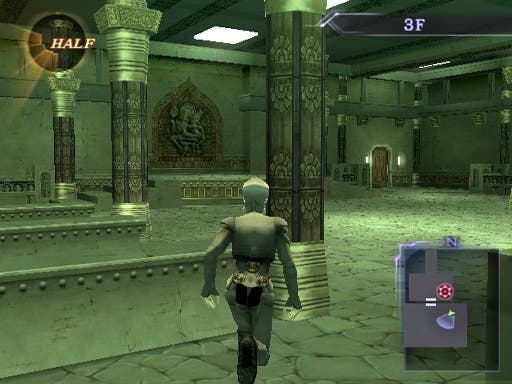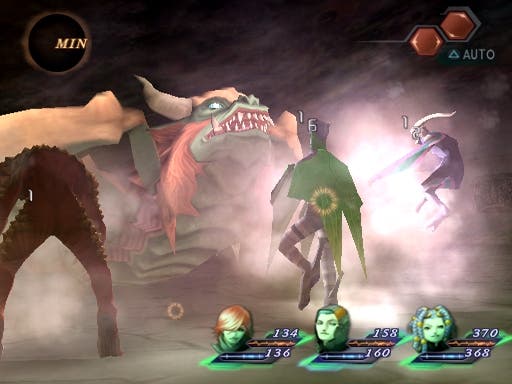Shin Megami Tensei: Digital Devil Saga
Devour the flesh of (and in) battle.
I eat a lot of weird stuff with glee; as I've often reflected half in jest and half with a heavy sense of sorrow, you don't get a figure like mine by being picky with your food. Ever since the discovery that a childhood of refusal to eat fish had somehow left me ravenous for sushi by my early twenties, I've made it my duty to explore the culinary fringes of the world and try everything at least once, and probably twice if I was drunk the first time. My kitchen contains spices and sauces whose names I cannot pronounce, and I'm whole-heartedly of the opinion that eating out is no fun unless the mere thought of at least one of the dishes would have given my dear old gran a heart attack.
That being said, I'm still not sure I'm ready for the Junkyard, the post-apocalyptic world in which Atlus has set the adventures of its latest Shin Megami Tensei game, Digital Devil Saga. Admittedly, I've never really fancied living in a scrapheap world where the last vestiges of civilisation engage in bloody battle in the hope of reaching a mythical Nirvana and you suspect that, at any moment, Kurt Russell might hobble over the nearest junk pile sporting an eye patch and a dodgy mullet; however, where the Junkyard is concerned, it's really the diet that worries me.
You see, Shin Megami Tensei: Digital Devil Saga is probably the world's first role-playing game about... Cannibalism. Yes, eating people. Actually, it's about eating pretty much everything that walks, squirms, flaps or waddles its unfortunate way into your path, but on a fairly regular basis that's going to involve munching down on some tasty Long Pig. Sorry, did I mention that like much of the SMT (or "MegaTen" if you prefer) franchise, Digital Devil Saga is distinctly not for the kids?
Appetiser

Digital Devil Saga shares a great deal in common with its predecessor in the European market, the stylish but rather flawed Shin Megami Tensei: Lucifer's Call. The simple yet dramatic art style makes a return, as does the signature post-apocalyptic world and the heavy use of religious overtones and iconography. The story, however, is completely disconnected from Lucifer's Call and set in an entirely new game world - one where a number of warring tribes, all that is left of civilisation, do battle in the hope of reaching Nirvana.
The game casts the player as Serph, a somewhat mysterious character (well, it wouldn't be a proper Japanese RPG if he didn't have Suspicious Elements To His Character and a Dark and Unexplored Past, now would it?) who leads one of those tribes, the Embryon Clan, in their struggle to escape the Junkyard and reach Nirvana. It opens with a battle between the Embryon Clan and their neighbours, the Vanguard Clan, which is interrupted by the appearance of an odd creature or organism in the battlefield - which triggers an event that unleashes a demonic force in each of the warring clansmen.
All hell, predictably, breaks loose - and straying almost at once into the not-for-kids category, the unleashed demons set about the aforementioned cannibalism with great gusto. Yum. From here on in, you control the Embryon clan as they attempt to use their newfound demonic powers to defeat the other clans and gain access to Nirvana - although, of course, it's not quite that simple, and the arrival of a woman who has the power to quell the demonic force with the sound of her voice will help to mix things up a little. Plus, there's always the question of whether it's really right, as such, to run around annihilating everyone else so you can go to heaven...
Main Course

In terms of how the game actually plays, veterans of Lucifer's Call will be right at home - this is a traditional turn-based RPG in essence, with three of your characters lining up against multiple nasties (not that some of your characters aren't nasty enough themselves, mind you). However, the twists to the formula are very welcome indeed, and act as an excellent refinement of the battle system. Still in the mix is the blocking system which allows you to defer an enemy's turn by hitting it with the right kind of elemental attack - essentially allowing you to continue pummelling an enemy without it getting a shot in at you, as long as you don't screw up. This proved to be a fascinating part of the gameplay in Lucifer's Call - and particularly essential on tough bosses - and it was good to see it return in Digital Devil Saga.
New in this iteration, however, is the levelling system, which replaces the arguably over-complicated and obscure levelling system found in Lucifer's Call with a system which apes the Sphere Grid in Final Fantasy X, and allows you to develop abilities along a number of branching paths. In order to fill in points on this grid, though, you'll need to chow down on your enemies - since levelling up is accomplished by devouring their flesh. Lovely! Actually, this is in itself quite an interesting aspect of the gameplay, because just killing enemies is often easier than knocking their health down low enough to be able to devour them, so it becomes a knack in itself to be able to finish a battle and have a nice dinner, rather than just wasting the opposition.
Overall, the battle system is a definite strong point - it's varied and involved enough to keep you interested, and backed up with a good levelling system which really makes you feel like you're customising your characters to your own purposes, and avoids rewarding you for hammering the same attack over and over. The addition of demonic forms for each of the human characters is also interesting - a little reminiscent of Shadow Hearts, in fact - and there's yet another layer of interesting choice to be made regarding whether to keep your characters in human form or cut loose in demonic form.
Cheese Board

If there was one complaint to be made about the battle system, however, it's a familiar one for fans of Lucifer's Call - we simply see too much of the bloody thing. The encounter rate of the game is very high, and much of the time you'll be wandering through huge, sparse dungeons which are really all about battling and levelling up for hours on end. This is forgivable to some extent because the battle system itself is so involving, but ultimately it spreads the story and character development of the game thinly over the experience, which is a shame because, otherwise, these would be major hooks.
The story is excellent, both mature and involving - a far cry from the fantasy worlds of many other RPG titles - and even the voice acting, often a bugbear in these titles, is pretty much uniformly on the money. However, slogging through dungeons for hours just to get a small amount of story payoff will leave many fans of narrative-heavy Japanese RPGs feeling a bit cheated, and not everyone will get into the battle system enough to enjoy it in its own right - especially in the latter half of the game, when the difficulty curve spikes significantly.
The sparse nature of the story will leave you feeling all the more cheated at the end of the game, when it emerges that this is simply the first half of a story which is continued in Digital Devil Saga 2. This would be fine if the narrative had been a little more concentrated in this first instalment; as it stands, it feels a little cheap to spread it so thin and then expect us all to hang on for a sequel.
Coffee
In other words, those thinking about purchasing this game should carefully consider what kind of gamer they consider themselves to be. If you're looking for a traditional Japanese RPG with a lot of story and character development - look elsewhere. However, what Shin Megami Tensei: Digital Devil Saga delivers in spades is an interesting, atmospheric RPG experience with an enjoyable battle system, fabulous music and an excellent visual style that set it well apart from RPG cliches of recent years. You just have to learn to love the dungeon grind - oh, and be prepared to devour the flesh of your enemies to progress in the world. No matter how many times our business team here at Eurogamer claim otherwise, we'll never believe that that's natural.

